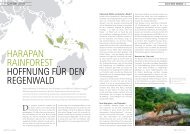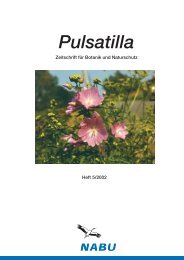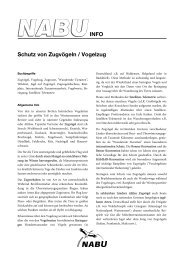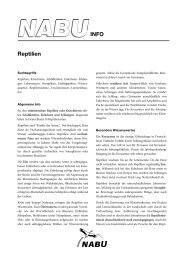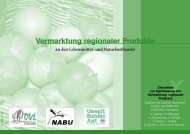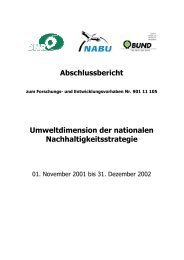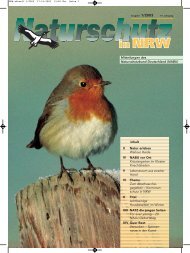Studie "The GMO-emperor has no clothes" (engl.) - Nabu
Studie "The GMO-emperor has no clothes" (engl.) - Nabu
Studie "The GMO-emperor has no clothes" (engl.) - Nabu
Create successful ePaper yourself
Turn your PDF publications into a flip-book with our unique Google optimized e-Paper software.
GM crops. <strong>The</strong> USDA data found that GM crops<br />
in the U.S. used more than 26 percent more<br />
pesticides per acre than <strong>no</strong>n-GM, conventional<br />
crops. 19 GM crops increased pesticide usage in the<br />
U.S. by 318.4 million pounds from 1996-2008. 20<br />
Much of the pesticide increase can be ascribed<br />
to the need to use more pesticides in an attempt<br />
to get rid of weeds that over generations have<br />
become resistant to glyphosate. From November<br />
2007 to January 2011, the number of reports<br />
of confirmed glyphosate-resistant weeds, also<br />
k<strong>no</strong>wn as “superweeds” in the U.S. nearly<br />
doubled from 34 to 66. Invested acreage more<br />
than quintupled, from 2.4 to 12.6 million acres.<br />
(According to aggregated data from the USDA.)<br />
On the federal level, eight agencies attempt<br />
to regulate biotech<strong>no</strong>logy using 12 different<br />
statutes or laws that were written long before<br />
GM food, animals and insects became a reality.<br />
<strong>The</strong> result <strong>has</strong> been a regulatory tangle. <strong>The</strong> U.S.<br />
Congress <strong>has</strong> yet to pass a single law intended<br />
to manage <strong>GMO</strong>s. In many ways, the Obama<br />
Administration promotes GM crops more<br />
vigorously than previous administrations. <strong>The</strong><br />
Administration views GM crops to be part of its<br />
strategy for reducing world hunger.<br />
In May 2011, the USDA approved a corn<br />
variety genetically engineered to resist drought.<br />
<strong>The</strong> corn was developed by a Monsanto and<br />
BASF partnership. However, the USDA’s draft<br />
environmental assessment <strong>no</strong>ted that the GM<br />
corn does <strong>no</strong>t seem to display any traits of<br />
drought resistance that are superior to many<br />
<strong>no</strong>n-GM corn varieties.<br />
<strong>The</strong> recent deregulation of GM alfalfa<br />
was approved even though the USDA’s<br />
environmental impact statement for GM alfalfa<br />
admits that gene flow between GM and <strong>no</strong>n-GM<br />
alfalfa is “probable.”<br />
<strong>The</strong>re are ongoing legal actions that include<br />
challenging the recent commercialization of<br />
GM alfalfa and plantings of GM sugar beets and<br />
halting cultivation of GM crops on public lands,<br />
to name a few.<br />
Mexico<br />
<strong>The</strong> debate over <strong>GMO</strong>s in Mexico centers<br />
around maize, or corn, as this is the core of<br />
peasant agricultural production and organization,<br />
the staple of the popular diet, and the heart of<br />
the culture. Maize is the legacy of the country’s<br />
ancestors. In Mesoamerican creation stories,<br />
the human race was modeled out of cornmeal.<br />
Mexico the center of origin, diversity, and<br />
domestication of this grain and <strong>has</strong> more than 60<br />
landraces and thousands of native varieties.<br />
<strong>The</strong> demise of maize in Mexico began with<br />
the passage of the North American Free Trade<br />
Agreement (NAFTA) which eliminated most<br />
trade “barriers” between the U.S., Mexico, and<br />
Canada. NAFTA, which took effect in 1994,<br />
resulted in massive imports of artificially cheap,<br />
subsidized corn from the U.S. This dramatically<br />
reduced maize farmer livelihoods in Mexico and<br />
dismantled rural eco<strong>no</strong>mies. It also provided a<br />
gateway for GM corn. As a result, corn imports<br />
from the United States increased three-fold<br />
after NAFTA, prices dropped by 50 percent, and<br />
3.2 million producers, the majority of Mexico’s<br />
small-scale producers found themselves under<br />
increasing eco<strong>no</strong>mic pressure. 21<br />
In 1999, scientists of the National Council of<br />
Agricultural Biosecurity helped to establish<br />
a de facto moratorium on experimental and<br />
commercial cultivation of GM corn in Mexico.<br />
A report issued at the 2002 Conference of<br />
Pugwash, concluded that “our current k<strong>no</strong>wledge<br />
is insufficient to evaluate the risks and benefits of<br />
<strong>GMO</strong>s, particularly in light of the short and long<br />
term consequences that these tech<strong>no</strong>logies could<br />
imply for the biosphere and future generations.”<br />
A major concern was that GM corn could<br />
contaminate Mexican landraces and varieties.<br />
In 2001, scientists from the University of<br />
California at Berkeley, Ignacio Chapela and<br />
David Quist, found that native corn varieties had<br />
been contaminated with transgenes from GM<br />
corn. <strong>The</strong> source of contamination was from<br />
U.S. corn imports, of which the majority was<br />
GM corn. (Mexico is the second largest export<br />
market for U.S. corn.)<br />
<strong>The</strong> 2005 Biosecurity and Genetically Modified<br />
Organisms Law, often referred to as the<br />
“Monsanto Law,” established three steps toward<br />
19<br />
Dr. Charles Benbrook, Impacts of Genetically Engineered Crops on Pesticide Use in the United States: <strong>The</strong> First<br />
Thirteen Years,” <strong>The</strong> Organic Center, Nov. 2009, p. 47 & Supplemental Table 7, http://www.organic-center.org/science.pest.<br />
php?action=view&report_id=159.<br />
20<br />
Benbrook, op. cit., p. 3.<br />
21<br />
De Ita Ana, Fourteen Years of NAFTA and the Tortilla Crisis, Americas Program Special Report, January 2008.<br />
34



